
Korean Painting of Saladin Entering Jerusalem
Source: https://farm4.staticflickr.com/3036/3010483390_df8442c07a_z.jpg
Excerpt from Chapter XIV: “… The articles of capitulation were signed on the 2nd of October (1187), the Feast of St. Leger. By a strange coincidence, it was the 27th of Rejeb, the anniversary of the blessed Leylat el-Miraj, when the prophet of Islam dreamed his wonderful dream, and visited in his sleep the Holy City which his followers had now recovered after ninety years of Christian occupation.
Balian returned to the city and announced the terms. They were accepted, with gratitude and lamentation. The people groaned and wept, and would not be comforted; they kissed the holy walls which they might never see again, and bowing their faces on the ground before the Sepulchre, watered the sacred spot with their tears. To leave Jerusalem was to tear the hearts out of them. But there was no help for it; the Moslem flag flew overhead, the keys were in the Saracen’s hands, and in forty days the city must be delivered up. Never did Saladin show himself greater than during this memorable surrender. His guards, commanded by responsible emirs, kept order in every street, and prevented violence and insult, insomuch that no ill-usage of the Christians was ever heard of. Every exit was in his hands, and a trusty lord was set over David’s gate to receive the ransoms as each citizen came forth.
Then began a strangely pathetic scene…”
Click Here to start at the beginning of this book OR Jump to the Table of Contents OR Jump to the Tables of Illustrations



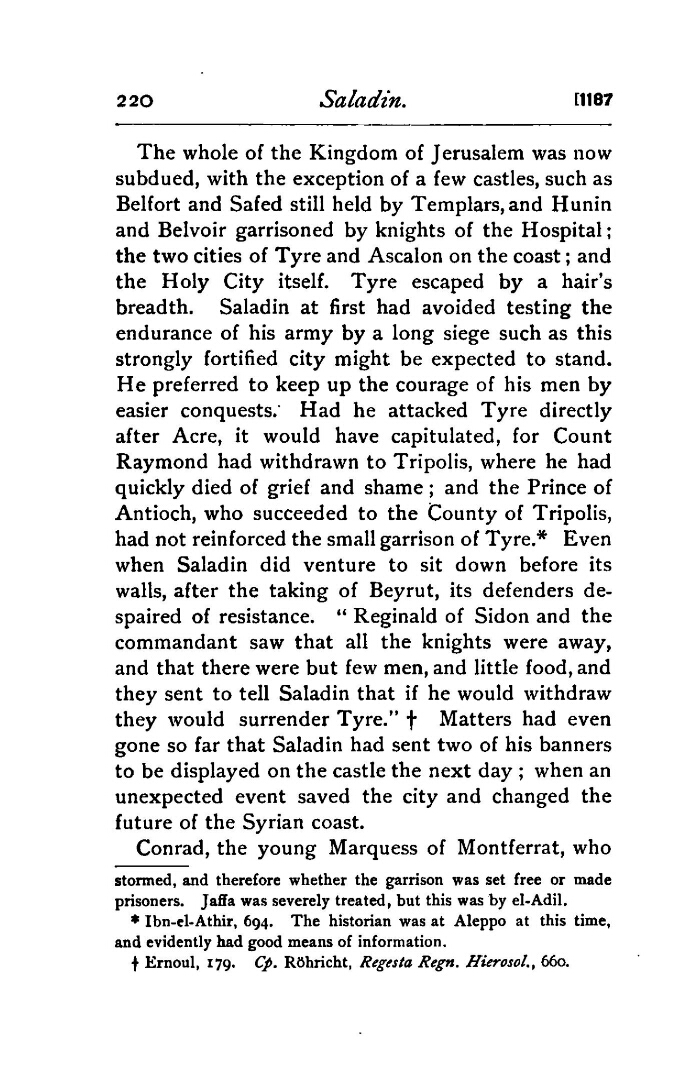
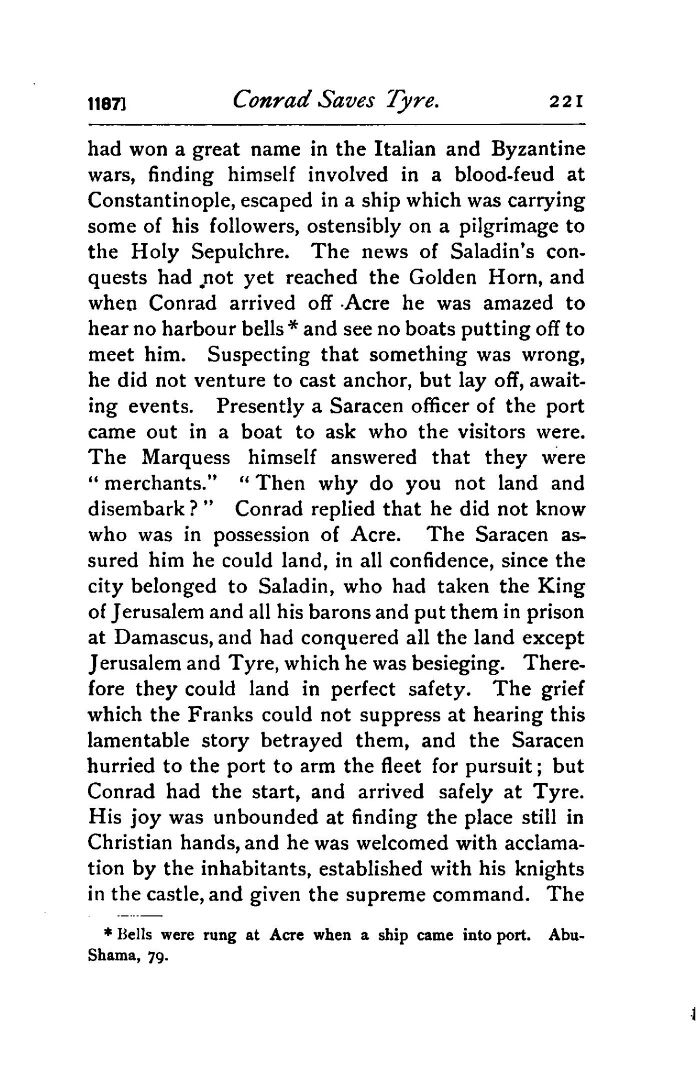


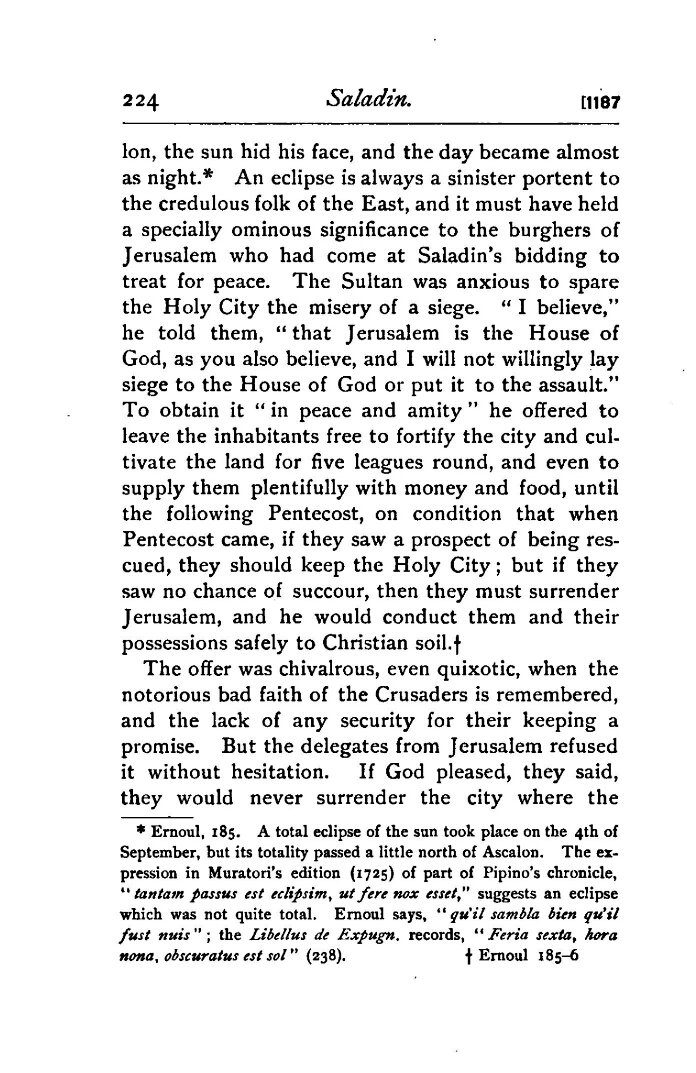

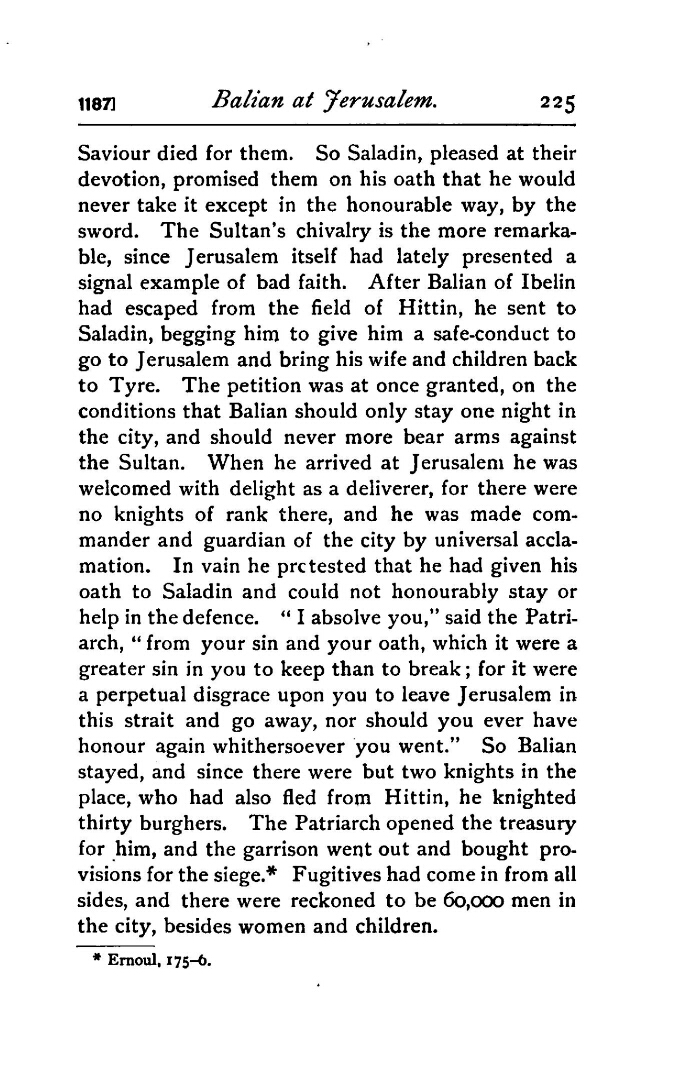
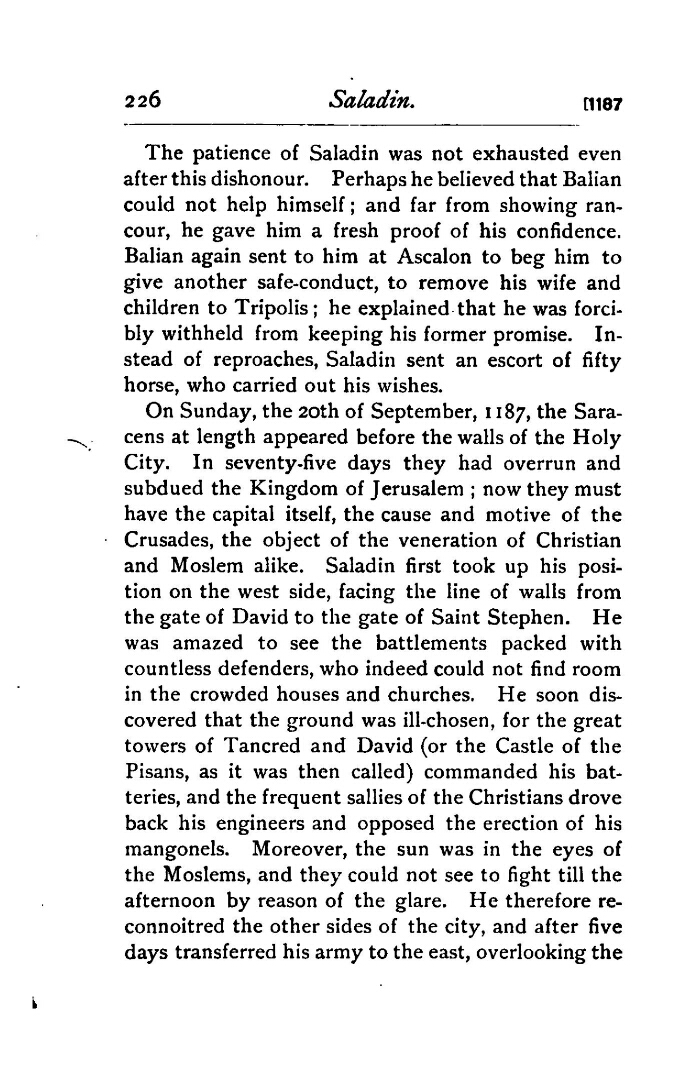
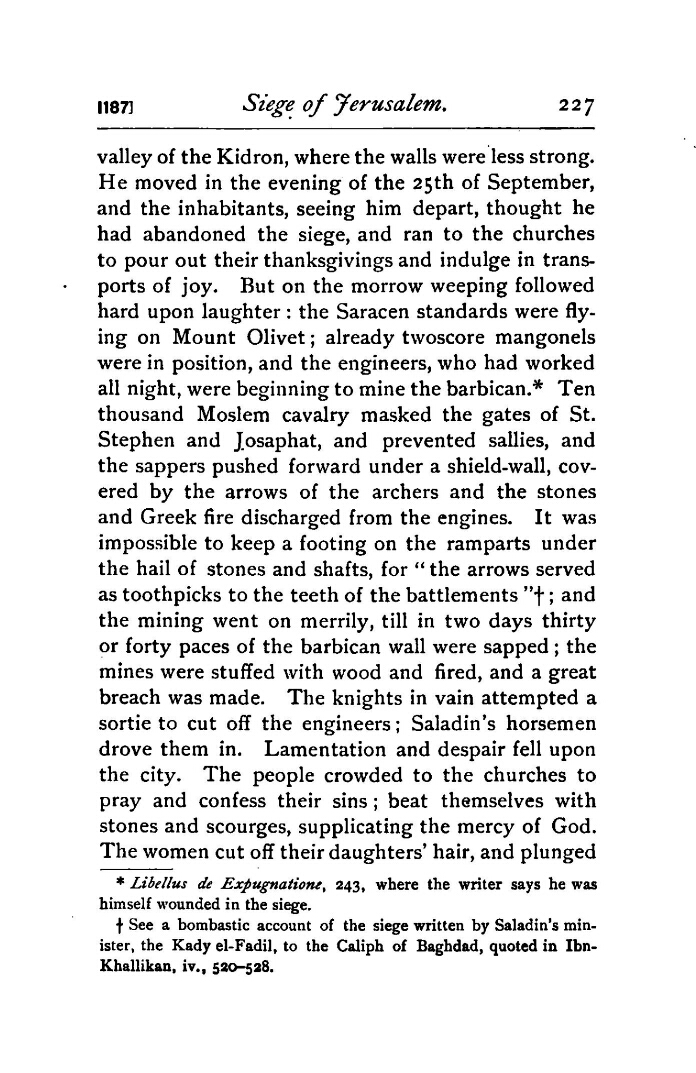
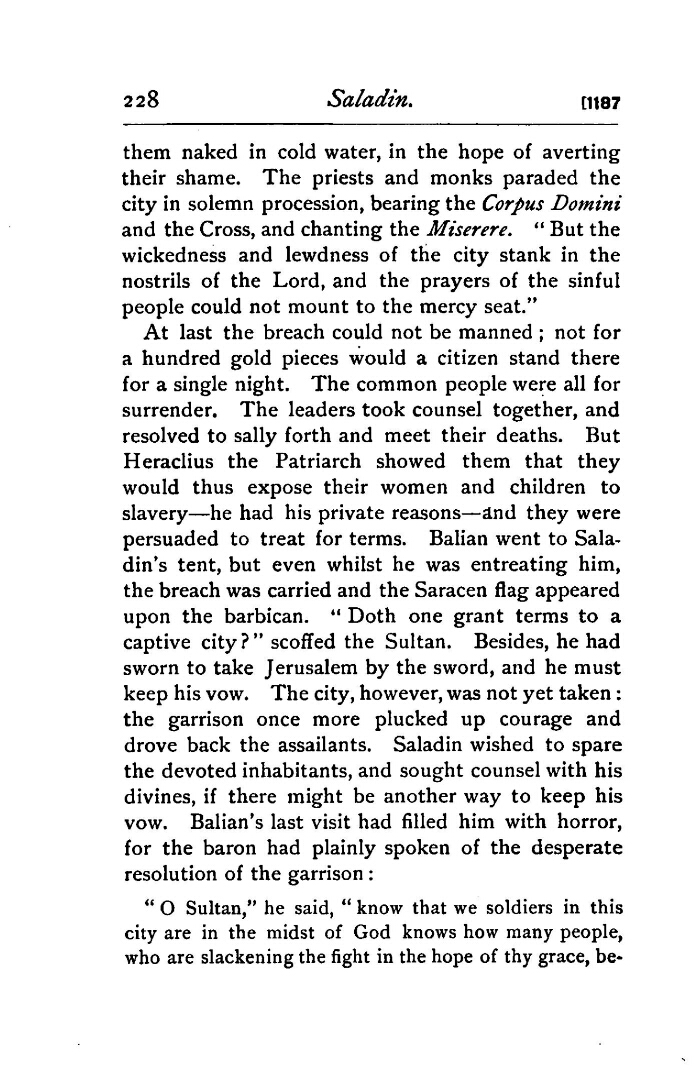
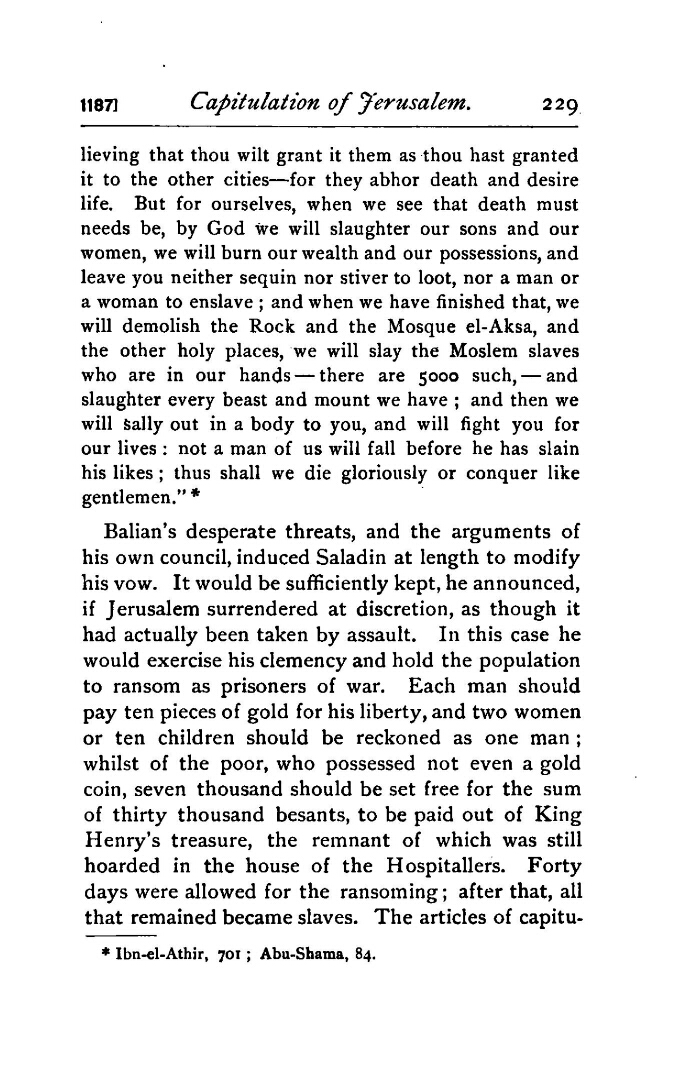


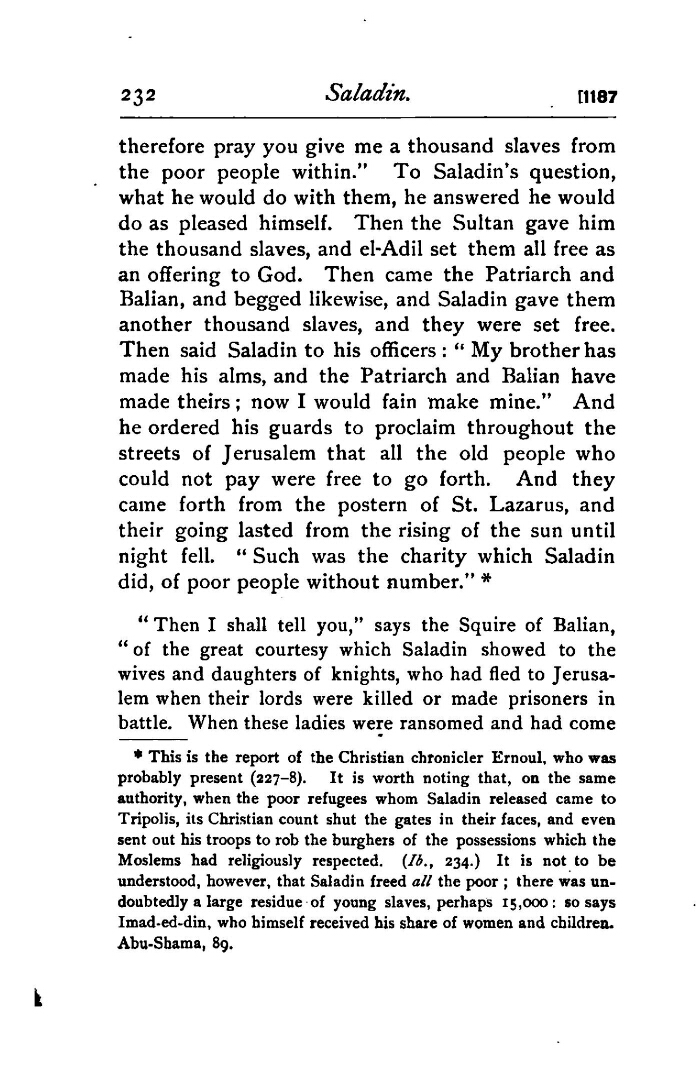
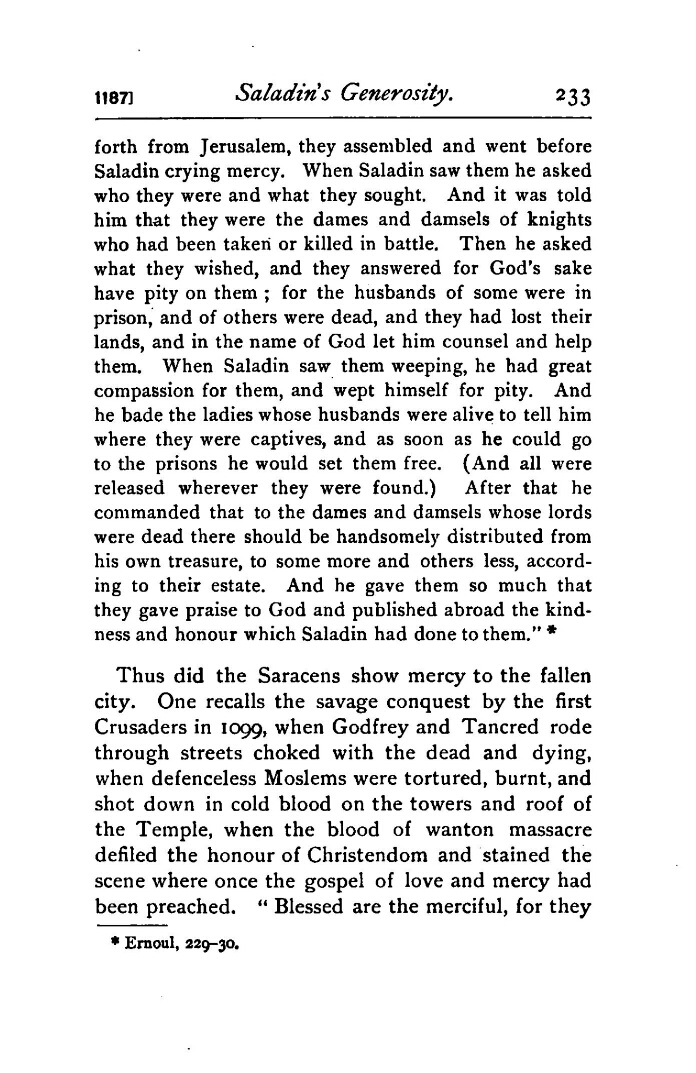
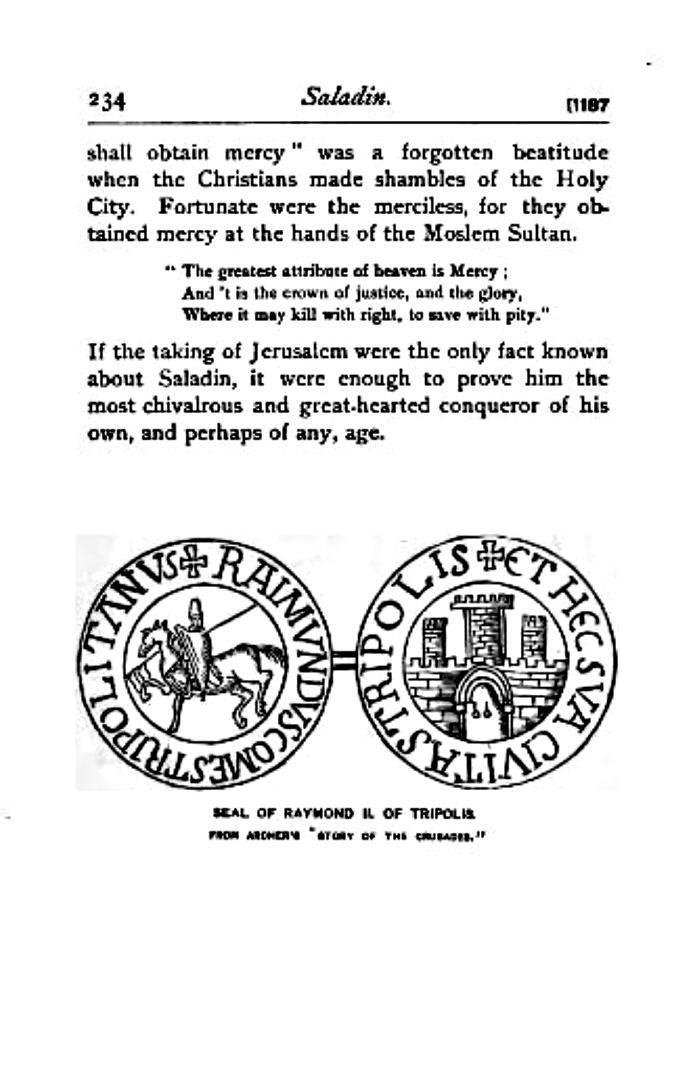
So interesting Aisha! so sad that there is still conflict to this day.!!
LikeLike
Yes, so sad, it’s just awful. Reading this history really puts a lot of perspective on it, doesn’t it? I really found it helpful to read – it’s a truly incredible time in history. Thanks so much for visiting me here, Cybele, I know you’re very busy and excited about your trip – I’m excited for you, too! Have fun! ♥♥♥ ;^)
LikeLike
Yes, I think it’s great to know the story well, because it is sad
LikeLike
Hi Maria! I took your advice from a while back and added a cover picture, hope you like it! And yes, the story in so many ways on so many levels is sad, and also sad that more people don’t know this history. But I’m always happy to see you! ♥♥♥ ;^)
LikeLike
Thanks, I do like the painting and illustration very much! Aisha, I have a confusion of who was Hermes Trismegistus. Wikipedia says “He may be a representation of the syncretic combination of the Greek god Hermes and the Egyptian god Thoth.” This goes back when Egypt was Hellenistic. Can you explain to me here (or in another post) whether the figure of Hermes Trismegistus has to do more with Christianization in general, and Islam has nothing to do with him? Why so much emphasis placed on Hermeticism?
LikeLike
Hi Maria, wow, what a fascinating journey you sent me on! I have often seen the similarities between the greek philosophies and the sufi theosophies and wondered about the relationship… I never imagined hermes would guide that journey, lol.
The best link I can give you, altho you will learn a lot by just googling “hermeticism in islam” is:
http://books.google.com.eg/books?id=TlKlc5reSyAC&pg=PA222&lpg=PA233&ots=9jHJP7Z5Pf&focus=viewport&dq=hermeticism+in+islam&output=html_text
Seems like that book covers it very comprehensively and it matches my own personal way of thinking in the final analysis.
Two other links were interesting for their ability to trace the path of greek philosophy to islam, via persia, not surprisingly:
http://mullasadra.blogspot.com/2010/03/hermeticism-in-islam.html
http://www.muslimphilosophy.com/ip/rep/H004.htm
And also fascinating is the path all this has taken into modern day masonic tradition:
http://www.surrenderingislam.com/surrendering-islam/hermetic-brotherhood-luxor
I don’t subscribe to sufism in particular, but in general I am drawn to their inner journeys of the soul in the quest for closer intimacy with Allah. I can understand how the early ideas of hermes as the deliverer of souls could easily manifest itself in the thinking of early sufis, as it has a basis in the teachings of Islam as well, for we know that an angel, by name “azra’il” will come for our souls at the moment of death and question us as to the principles of our faith before leading us to wherever Allah has appointed for our souls after our physical death. Allah guide us carefully to the Paradise, insha’Allah (God willing)!
Hope this helps, it was really quite fascinating! ♥♥♥ ;^)
LikeLike
One more train of thought, Maria, I didn’t cover the path of the hermetics thru christianity – as you may recall, John the Baptist was of a hermetic order, dont quote me, but I think it was the essenes, and followed similar traditions of thought. Jesus is considered the shepherd, similar to the notion of hermes. The early christians had lots of trouble conglomerating doctrines, and the gnostics were basically kicked out of the club, but they are the link between hermetics and christianity, and also islam, in both cases the link is the christian order of Sabbaens or Sabbians – with their strong emphasis on the oneness of God, especially. Sabba’ refers to the number 7, as in the sanctity of the 7th day of creation, and I dont know this for certain, but I think we can find early roots in this camp for the modern 7th day adventists christians.
Fascinating, Maria, thanks again! ♥♥♥ ;^)
LikeLike
Thanks so much for the links. I guess I was wondering what specific role did Hermes Trismegistus have since he’s said to be linked to the Christian movement.
LikeLike
I wouldnt be surprised if his name, meaning roughly, “3 in 1”, figures somewhere in the early trinity christian ideology.
LikeLike
Just as you replied, I was reading this article:
http://en.wikipedia.org/wiki/Paganism
I realized that it is actually quite complex to understand what Paganism actually was.
LikeLike
Lol, it’s everything that doesn’t match the theology of whomever you are speaking to at that moment! Religion is slippery like that!
LikeLike
Hey! I’ve just nominated you for the liebster award and have 11 fun questions for you to answer >> http://misszuhkey.blogspot.com/2014/08/i-got-accepted-nominated-for-liebster.html
Enjoy! x
LikeLike
Thank you very much Miss Zuhkey! I already have a Liebster, so I will gently decline with my thanks, however, if I have time to recycle it out to others, I will gladly do that! I will come to visit you as soon as possible, congrats to you and thank you once again! ♥♥♥ ;^)
LikeLike
I quote from the article:
“By late antiquity, however, it was possible to speak Greek as a primary language while not conceiving of oneself a “Hellene”. The long-established use of Greek in and around the eastern Roman Empire a lingua franca ironically allowed it to instead become central in enabling the spread of Christianity—as indicated for example by the use of Greek for the Epistles of Paul. In the first half of the 5th century, Greek was the standard language in which bishops communicated,and the Acta Conciliorum (“Acts of the Church Councils”) were recorded originally in Greek and then translated into other languages.”
Isn’t it interesting?
LikeLike
Oh, yes, it is! I studied new testament greek, and it’s very helpful for reading original nt bible verses. The trouble with it is, for example, Jesus didn’t speak greek, so every word we have ascribed to him in the nt bible is in fact a translation, not a direct quote. Not very different from understanding what we know of Socrates is actually whatever Plato wanted us to know… but at least they both spoke the same language! Translations are as slippery as religions, lol, and equally easily to manipulate according to the agenda of the translator. Early Christianity is a tangled mess worse than spagetti, have fun, but wear an apron!
LikeLike
Hi my sweet friend Aisha ! Just a quick visit to say hi and to tell you how much I miss your work and our long chats … Sorry for M I A,still on hols and I don’t want to play favourtes …
Warm Greetngs from UK and lots of love your ways ❤️❤️❤️
PS : I am dead sure your post is interesting,but I cannot go through it now.
Stay well , Doda :))))))))))) xxx
LikeLike
Lol, happy holidays, dear Doda, I miss you very much too! Have a great time, so sweet of you to pop in! ♥♥♥ ;^)
LikeLike
Reading through the history is a sad tale.. And yet compassion was found.. I hope for the sake of many more living now that compassion and reconciliation can bring together those who have so long been torn apart..
Love and Peace are wished for many places right now… Bless you Aisha for this post.. Its very illuminating to read.. and puts many things of the past into perspectives of why down through time such divisions exist..
>3 Sue
LikeLike
That is so true, Sue, the historical records can be sooo illuminating! (and time can be so forgetful, lol) I was so amazed by this book,and by the big picture that I got from reading it, it had a huge impact on the way I view politics… So sad that nothing has really changed all that much after all these years, and so sad the miserable stereotypes we are are often prejudiced by… But the truth always comes out, I think that must be one of basic laws, lol, like gravity or something! Thanks so much for visiting me here, I’ve really enjoyed your presence! ❤❤❤;^)
LikeLiked by 1 person
Likewise Aisha.. and it was lovely to read this informative post.. Big Hugs, oh and I am settling into retirement.. Just where have the last 12 days gone?… 🙂 Love and Blessings and always so good to see you too upon Dreamwalker’s.. You sound to be very busy with your various writing now on your other sites…. Wishing you well with both of them.. 🙂 Hugs Sue x
LikeLike
Hugs back!
❤❤❤;^)
LikeLike